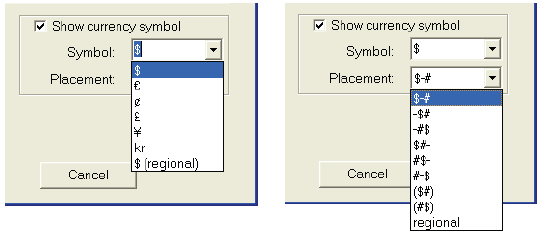Number formats
The Number format dialog lets you control the format of numbers and dates displayed in tables, graphs, and input or output fields. You can select options like the number of decimal digits, currency signs, and commas to separate thousands. The default number format is suffix, which uses a letter following the number, such 10K to mean 10,000 (where K means Kilo or thousands).
The number format of a variable is used wherever the value of that variable appears —in a result table, graph, input field, or output field. The number format of an index applies wherever that index is used, including row or column headers of a table, or along an axis of a graph that uses that index.
You can enter a number into an expression or table in any format, no matter what output format it uses.
To set the number format for a variable:
- Select a variable by showing its edit table, result table, or graph, or by selecting its node in a diagram. To apply the same format to several variables, select their nodes together in a diagram.
- Select Number format from the Result menu, or press Control+b, to show this dialog.

- Select the format type you want from the list on the left.
- Select options you want, such as Decimal digits, Show trailing zeroes, Thousands separators, or Show currency symbol, from checkboxes, menus, and fields on the right. The options available depend on which format you selected.
- View the example at the top of the dialog to see if the format is what you want.
- If so, click the Apply button.
You can change the default number format by pressing Set Default. The default format applies to all variables in your model whose number format has not been explicitly set.
Format types: Choose one of these number formats:
Suffix characters: Suffix is Analytica’s default format. It uses a conventional letter after each number to specify powers of 10: 12K means 12,000 (K for kilo or thousands), 2.5M means 2,500,000 (M for Mega or mil- lions), 5n means 0.000,000,005 (n means nano or billionths). Here are the suffix characters:
Maximum precision: The maximum number of digits including decimal digits is 15 (14 for fixed point and percent); the maximum precision is 15 digits (9 for integers).
Number format options
Decimal digits: The number of digits to show after the decimal point.
Show trailing zeroes: Check to show trailing zeroes in decimals, e.g., 2.100 instead of 2.1, when decimal digits are set to 3.
Thousands separators: Check to show commas between every third digit of the integer part, e.g., 12,345.678, instead of 12345.678.
Show currency symbol: Check to show a currency symbol. Select the symbol and placement from these menus.
Placement controls the relative location of the currency symbol, e.g., $200 or 200DM, and whether to use a minus sign -$200 or parentheses ($200) to indicate a negative number.
Regional settings: If you select the last entry, regional, from the Symbol or Placement menu, it uses, respectively, the regional currency or placement settings set for your computer. You can modify these settings in the Regional and Language options available from the Windows Control Panel.
See Also
| Chapter 7: Formatting Numbers, Tables, and Graphs <- | Number formats | -> Date formats |



Enable comment auto-refresher